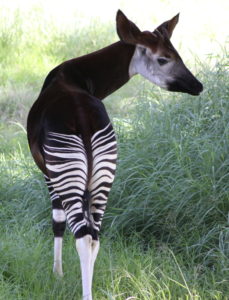The Elusive Okapi
Genesis 1:25 “And God made the beast of the earth after his kind, and cattle after their kind, and every thing that creepeth upon the earth after his kind: and God saw that it was good.”
 The teacher looked at his students as they hung on his words. They were silent. It was very difficult to get them to answer his questions. “So, then, class,” he began, “what family does the okapi belong to?”
The teacher looked at his students as they hung on his words. They were silent. It was very difficult to get them to answer his questions. “So, then, class,” he began, “what family does the okapi belong to?”
He had showed them a picture of an okapi on the screen and emphasized some of the characteristics it shared with its taller cousin. He had shown them its long, blue tongue, and its skin-covered little horns on its head. “Come on,” he urged, as the silence became deafening. “Someone must know! Johnny, do you know what family the okapi belongs to?”
Johnny considered the question thoughtfully. “Please, sir, I don’t know!” he said at last. “There’s no family on our street has one.”
In fact, the okapi is the smaller, shorter-necked, much less well-known member of the family giraffidae, whose only other member, as you might guess, is the giraffe. Wikipedia suggests that a common ancestor of giraffe and okapi existed some 11.5 million years ago. The timescale was estimated by comparing the very similar DNA of the two species and estimating how long it might take for the various necessary genetic substitutions to take place. We would not accept that timescale, but the relationship seems to be undeniable. Therefore, we assume that the giraffidae family is, in fact, the giraffidae biblical kind, and, therefore, giraffe and okapi do indeed possess a common ancestor. This is not evolution. This is speciation within a kind, as described in the Bible.
Author: Paul F. Taylor
Prayer: We know, Lord, that You are in control. We know that You planned the wide variety of animals, and the wide variety of characteristics within each created kind. Amen.
Ref: Agapa, M. et al (2016), Giraffe genome sequence reveals clues to its unique morphology and physiology, < https://www.ncbi.nlm.nih.gov/pmc/articles/PMC4873664/ >, accessed 5/31/2018. Image: CC BY-SA 2.0.